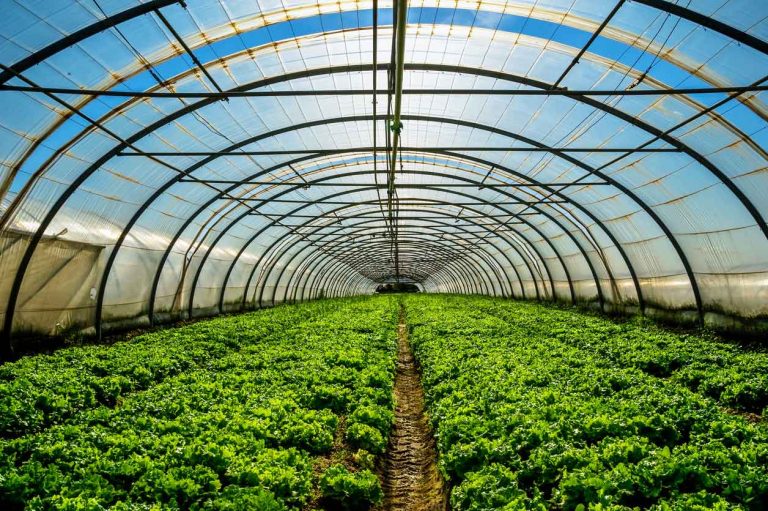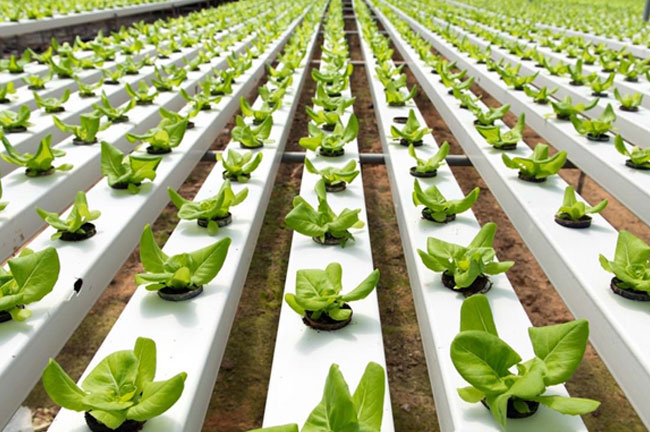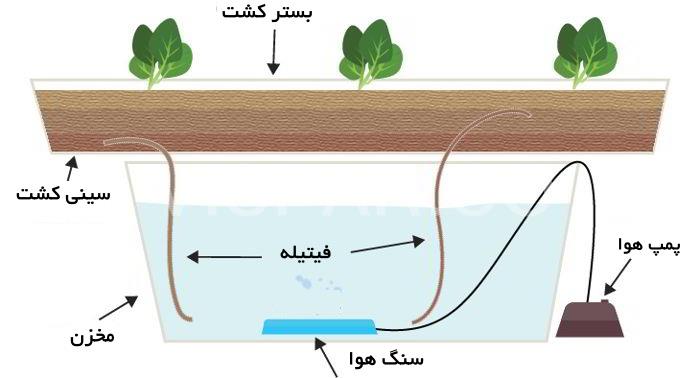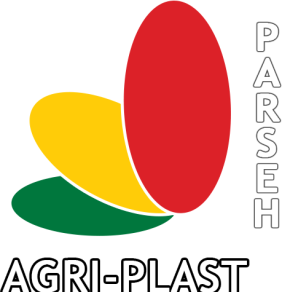
وبلاگ
What is a hydroponic greenhouse and what are its uses and benefits?

A hydroponic greenhouse refers to a controlled environment where plants are grown in special nutrient solutions without the need for soil. In this system, plants can get more benefits and efficiently absorb nutrients and water. Hydroponic greenhouses usually consist of the following elements:
The structure of the greenhouse

The structure of the greenhouse
The structure of the greenhouse is designed in such a way that the environmental conditions are optimal for the growth of plants. This includes the use of transparent materials for the walls and roof, which transmits natural light into the greenhouse. Also, the use of ventilation systems, adjustable windows and thermal insulation can help maintain the ideal temperature and humidity.
Hydroponic cultivation systems
In hydroponic greenhouses, there are different methods for growing plants, including the following:
NFT (Nutrient Film Technique): In this method, a thin layer of nutrient solution is slowly spread over the roots of plants. This system allows plants to easily absorb nutrients.
Deep Water Culture (DWC): In this method, plant roots are placed in a deep water tank containing a nutrient solution. This method allows plants to continuously benefit from water and nutrients.
Ebb and Flow: In this system, water and nutrient solution alternately reaches the roots of the plants and then returns to the tank. This method helps to provide oxygen and nutrients.
Environmental management
In hydroponic greenhouses, controlling environmental conditions is very important. This includes regulating temperature, humidity, light and air flow. For this, various tools are used such as sensors, fans, humidifiers and exposure systems.
nutrients
In hydroponic cultivation, plants use nutrient solutions directly. These solutions usually contain all the nutrients needed for plant growth, including nitrogen, phosphorus, potassium, calcium, magnesium, and micronutrient elements such as iron, zinc, and copper.
conclusion
A hydroponic greenhouse is a modern and efficient cultivation system that allows farmers to grow plants optimally in controlled environments. This method not only helps to increase food production, but can also lead to preserving water resources and reducing pollution.
Why hydroponic cultivation?

Saving resources
Hydroponic cultivation significantly reduces the amount of water consumed due to the lack of soil. Compared to traditional farming methods, this method can use up to 90% less water. Also, plants in this system directly benefit from nutrient solutions, which reduces the need for chemical fertilizers and pesticides.
Increase productivity
Hydroponic cultivation can lead to increased production and quality of products due to strict control of growth conditions. Plants in this system use nutrients directly and therefore grow faster. Many farmers report that they can harvest up to two or three times a year in hydroponic systems.
No dependence on geographical conditions
One of the biggest advantages of hydroponic cultivation is that farmers can cultivate in areas with unfavorable weather conditions. This method is especially effective in dry or cold climate areas where traditional cultivation is difficult. With hydroponic greenhouses, crops can be harvested at any time of the year.
Reducing pests and diseases
By removing soil from the cultivation process, the risk of soil-borne pests and diseases is minimized. This allows farmers to use fewer chemical pesticides and, as a result, produce healthier crops.
Cultivation in small spaces
Hydroponic cultivation allows farmers to cultivate plants in small and urban spaces. This system is especially suitable for people who live in apartments or in areas with limited space. By using vertical cultivation techniques, less space can be used for more production.
Improving the quality of products
Crops grown in hydroponic systems are usually better in quality and taste than those grown in soil. The reason for this is the direct access of plants to nutrients and the precise control of growth conditions. Many farmers who have switched to hydroponics have seen a dramatic improvement in the quality of their crops.

conclusion
Hydroponic cultivation is a new and efficient method in modern agriculture, which has become very popular due to its many advantages, including saving water, increasing productivity and reducing pollution. Considering the global challenges in food supply and natural resource management, hydroponic cultivation can be proposed as a sustainable and effective solution in the future of agriculture.
Irrigation system
The importance of irrigation in hydroponic cultivation
Irrigation is one of the key factors in hydroponic cultivation. This system allows plants to have continuous access to water and nutrient solutions. Due to not using soil, careful management of water and nutrients is very important for healthy plant growth.
Irrigation methods
Drip irrigation system: In this system, water and nutrient solution are directly and slowly transferred to the roots of plants through thin and drip pipes. This method not only helps to save water, but also prevents the wastage of nutrients.
Flood system (Ebb and Flow): In this method, the plant bed is temporarily filled with nutrient solution and then returned to the tank. This action helps to supply oxygen to the roots and provides ideal conditions for the growth of plants.
Deep Water Culture System: In this system, the roots of the plants are immersed in a deep water tank that contains a nutrient solution. This method allows plants to continuously use water and nutrients.
Water managementProper water management in hydroponic systems helps prevent diseases and pests. The use of sensors and advanced technologies to control and monitor the water level and humidity helps to improve the performance of the irrigation system.
Exposure system
The importance of light in plant growth
Light is one of the most important factors affecting the growth of plants. In hydroponic cultivation, especially in closed environments, the use of natural light may not be enough. Therefore, artificial exposure systems are essential.
Types of exposure systems
LED lamps: These lamps are among the most popular options in hydroponic greenhouses due to their low energy consumption and the ability to produce various light spectrums. LED lamps can provide the light needed for different stages of plant growth.
Fluorescent lamps: These lamps are suitable for young plants and early stages of growth. They are good options for home and small farms due to their low cost and ease of installation.
Metal Halide Lamps: These types of lamps are very effective for the growth of mature plants and fruit production. They produce more light in the blue and white spectrum, which helps plants grow fast and healthy.
Control of light conditionsAdjusting the intensity and duration of exposure is very important for plants in different stages of growth. Automated systems for controlling light cycles allow farmers to provide ideal conditions for plants.
Moisture and air system
The importance of humidity
Proper humidity in hydroponic greenhouses is very important to prevent diseases and increase plant growth. Very high humidity can lead to the growth of fungi and plant diseases.
Humidity control systems
Humidifiers: These devices are used to increase air humidity in greenhouses and help create ideal conditions for plant growth.
Fans and ventilation systems: Fans help create proper air flow and reduce humidity in greenhouses. These systems can help prevent the accumulation of moisture and the occurrence of diseases.
Air quality managementThe air quality in hydroponic greenhouses should be such that the plants can breathe easily. Using air filters and proper ventilation systems will help improve air quality and help plants grow healthy.
pH and EC control system
Importance of pH and EC control
Controlling pH and electrical conductivity (EC) is one of the most important points in hydroponic culture. The optimal pH is usually between 5.5 and 6.5 for most plants, and EC represents the concentration of nutrients in solution.
Control tools
pH and EC sensors: These tools allow farmers to continuously monitor pH and EC and make adjustments as needed.
Automated systems: Some hydroponic systems can automatically adjust pH and EC, helping plants grow in optimal conditions.
Effect on plant growthAccurate control of pH and EC can help to increase the yield and quality of products. If these factors are ignored, plants may suffer from a lack or lack of absorption of nutrients, which leads to a decrease in quality and production.
Nutrient Flow System (NFT)
The concept of NFT
The NFT (Nutrient Film Technique) system is one of the modern hydroponic methods in which a thin layer of nutrient solution flows slowly over the roots of plants. This system allows plants to easily absorb nutrients and achieve faster growth.
Advantages of the NFT system
Reduced water consumption: This system greatly reduces water consumption due to low water flow and helps farmers to use water resources more efficiently.
High production: Plants in this system usually grow at a higher rate, which helps increase production efficiency. In addition, this system allows for vertical cultivation that takes up less space.
NFT system managementProper management of the NFT system includes continuous monitoring of water level, pH and EC of the nutrient solution. Also, keeping the flow channels clean and preventing the accumulation of pollutants is very important to maintain the optimal performance of the system.
Challenges and solutions
Despite its many advantages, the NFT system can also face challenges, including the possibility of root desiccation

Where is hydroponic culture used?
greenhouses
Greenhouses are one of the most common places for hydroponics. In these controlled environments, farmers can provide optimal conditions including temperature, humidity and light for plants. This method is particularly effective in areas with unfavorable climates, as farmers can cultivate in any season of the year.
Vertical gardens
Vertical gardens are a suitable solution for hydroponic cultivation in urban areas with limited spaces. By using hydroponic systems in these gardens, it is possible to grow plants at a height and make optimal use of space. This method helps to reduce environmental effects and increase urban beauty.
Apartments and interior spaces
Due to the need for less space and the ability to control environmental conditions, hydroponic cultivation is also possible in apartments and indoor spaces. Using small hydroponic systems, residents can grow vegetables and herbs indoors.
Industrial farms
In large and industrial farms, hydroponic cultivation is used as an effective method to increase production and reduce costs. These systems allow farmers to produce high-quality crops consistently and on a large scale.
Research and educational centers
Research and educational centers also use hydroponics to study and teach about modern farming techniques. These locations allow students and researchers to learn about hydroponic processes and experiment with new techniques.

Some plants are not suitable for layer cultivation
Plants with deep roots
Some plants that have deep and large roots are usually not suitable for hydroponic cultivation. These plants need more space to grow and may face limitations in hydroponic systems. For example, plants such as potatoes or carrots are not usually grown in these systems due to the depth required for their roots.
Plants with special needs
Some plants require special conditions for growth that may not be available in the hydroponic system. For example, tropical plants that require very high humidity may not do well in hydroponic conditions.
Plants with a long growing period
Plants that have a long growth period and need more time to reach maturity may face challenges in hydroponic systems due to the need for precise control of environmental conditions.
What plants are suitable for hydroponic cultivation?
Leafy vegetables
Vegetables such as lettuce, basil, and spinach are among the best options for hydroponic cultivation. These plants grow quickly and respond well to hydroponic conditions.
Medicinal plants
Herbs such as mint, thyme, and rosemary are also good options for hydroponic cultivation. These plants perform well in these systems due to the need for less space and fast growth.
Fruity vegetables
Fruit vegetables such as tomatoes, bell peppers and cucumbers are also suitable for hydroponic cultivation. These plants usually need more nutrients and using hydroponic systems can help them grow quickly and optimally.
Flowers and ornamental plants
Many flowers and ornamental plants also grow well in hydroponic systems. These plants usually require specific light and humidity conditions that can be provided by control in hydroponic greenhouses.

The cost of hydroponic cultivation and hydroponic greenhouse
Initial investment
The cost of hydroponic cultivation is usually higher than traditional cultivation, especially in the early stages that require advanced equipment and technologies. The initial investment includes the costs of building a greenhouse, purchasing irrigation and lighting systems, and raw materials for cultivation.
Current costs
Running costs of hydroponics include water consumption, electricity (for lighting and ventilation systems), and nutrient costs. These costs depend on the type of hydroponic system and the scale of production.
Return on investment
Despite the high initial costs, hydroponic cultivation can have a good return on investment due to increased production and product quality. Many farmers are able to recoup initial costs and become profitable after a few growing seasons.
Economic benefits
Hydroponic cultivation allows farmers to produce crops in different weather conditions and at any time of the year. This issue helps to increase the variety of products and meet the needs of the market and can lead to job creation and economic prosperity in different regions.
Javaneh Poosh Parseh
Company introduction
Javaneh Poosh Parseh Company was established with the aim of promoting and developing the modern agricultural industry in Iran. As one of the reliable producers of polymer products in Shiraz, this company tries to meet the needs of farmers and producers by providing high quality and innovative products.
Our products
Javaneh Poosh Parseh company produces and supplies all kinds of polymer products needed in agriculture and greenhouses. Our products include the following:
Greenhouse Nylon: High-quality and durable nylons used to cover greenhouses and help maintain indoor temperature and humidity.
Agricultural plastic: types of agricultural plastics for use in different crops that help improve the quality of products and reduce pests.
Shrink: Shrink products used to package and protect products from external factors.
Shrink nylon: special nylons for packaging goods in order to maintain quality and increase the useful life of products.
Plain wide plastic: These plastics are used for covering and use in various agricultural projects.Consulting services
Javaneh Poosh Parseh also provides consulting services in the field of hydroponic cultivation and greenhouse management. Our team consists of experienced specialists in this field and is ready to help farmers and enthusiasts in all stages of cultivation and production.
Company values
We adhere to the following values at Jovane Posh Parse:
Quality: focusing on the production of quality products and international standards.
Innovation: using new technologies to improve production processes and provide new solutions to customers.
Customer support: providing specialized services and advice to help customers in all stages.contact us
We at Parse Sprout Company are always ready to answer your questions and needs. You can contact us through the following methods:
Contact information
Phone: 09017606868 07137742366-9
Address: Big Industrial City of Shiraz, Sooreh Square, South Sooreh Blvd., 203 St.
Website: javanehpoosh.com
